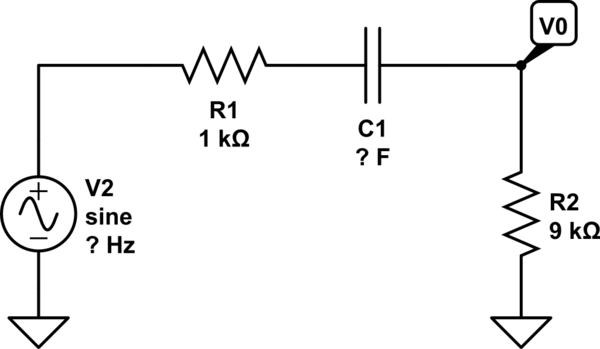From the transfer function, I ended at a rather interesting answer:
$$H(j\omega) = \frac{j \omega C_1 R_1}{j \omega C_1 (R_1 + R_2) + 1}$$
$$abs(H) = \frac{\omega C_1 R_1}{\sqrt{\left(\omega C_1 (R_1 + R_2)\right)^2 + 1}}$$
Finding cutoff frequency (step by step, so we don't trip):
$$\frac{\omega_0 C_1 R_1}{\sqrt{\left(\omega_0 C_1 (R_1 + R_2)\right)^2 + 1}} = \frac{1}{\sqrt{2}}$$
$$\frac{(\omega_0 C_1 R_1)^2}{\left(\omega_0 C_1 (R_1 + R_2)\right)^2 + 1} = \frac{1}{2}$$
$$(\omega_0 C_1 R_1)^2 = \frac{\left(\omega_0 C_1 (R_1 + R_2)\right)^2 + 1}{2}$$
$$(\omega_0 C_1 R_1)^2 - \frac{\left(\omega_0 C_1 (R_1 + R_2)\right)^2}{2} = \frac{1}{2}$$
$$(\omega_0 C_1)^2 \left(R_1^2-\frac{\left(R_1 + R_2\right)^2}{2}\right) = \frac{1}{2}$$
$$\omega_0 C_1 = \frac{1}{\sqrt{2\left(R_1^2-\frac{\left(R_1 + R_2\right)^2}{2}\right)}}$$
$$\omega_0 C_1 = \frac{1}{\sqrt{2\left(R_1^2-\frac{R_1^2 + 2R_1R_2 +R_2^2}{2}\right)}}$$
$$\omega_0 = \frac{1}{C_1\sqrt{R_1^2-2R_1R_2-R_2^2}}$$
I did not reach your book's very-well known formula, yet seemingly incorrect for this application. I could only bet the one who wrote the solution just botched it. Or I did. Eitherway, there's my two cents.

